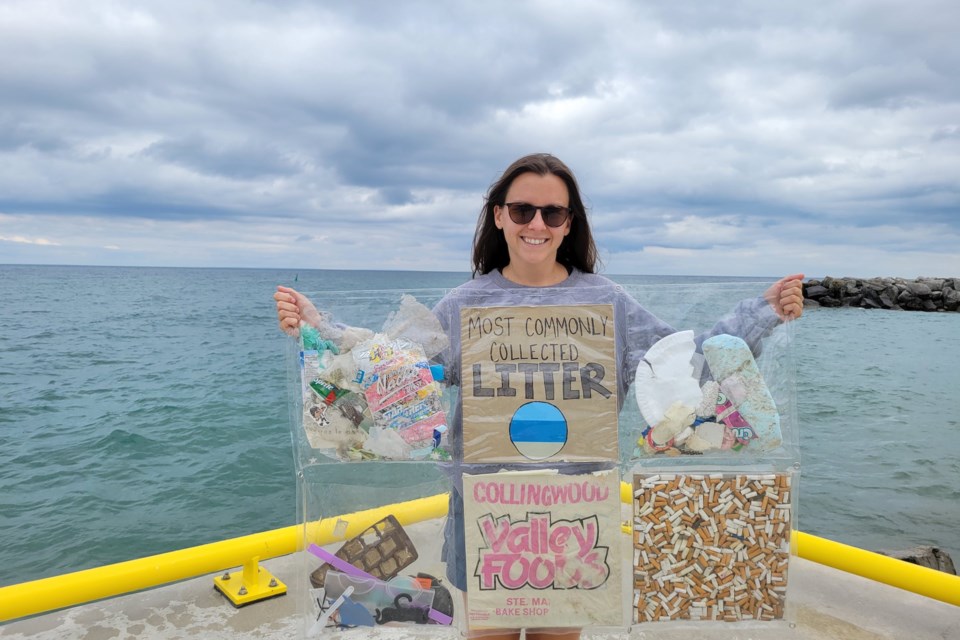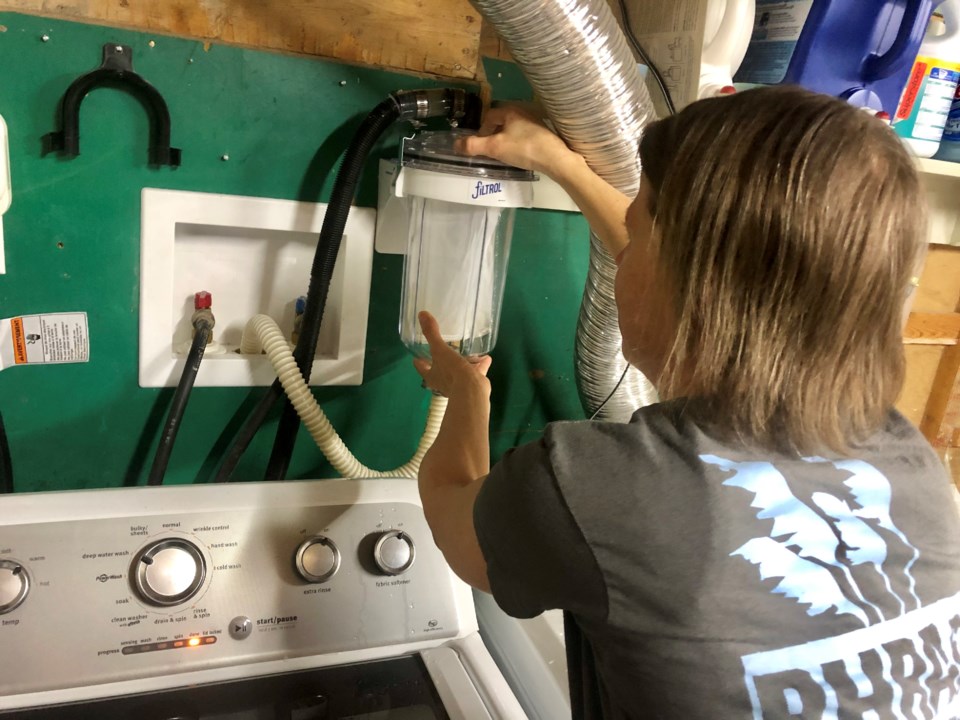A recent experiment conducted in Collingwood and Parry Sound has shown that microplastics can be caught before they end up in a wastewater treatment plant, and then likely in large bodies of water like Georgian Bay.
Georgian Bay Forever has spent the last four years installing filters onto washing machines in 97 households in Parry Sound and 304 households in Collingwood in an attempt to test whether filtering the effluent from washing machines will have any marked effect on preventing microplastics from ending up in wastewater and being sent into the Great Lakes post-treatment.
Based on the weight of the lint collected from those households (80 kilograms in total), Ashley Morrison, the manager of divert and capture projects for Georgian Bay Forever, noted there were between 2.25 and 34 billion microplastics diverted from wastewater by the filters.
"The project was a really big success," Morrison said in a phone interview. "There was a lot of awareness and education that came with it, which is a major driving factor for any divert-and-capture program."
Microplastics are bits of plastic less than five millimetres in size that come from a variety of sources. For example, a plastic cup tossed in a landfill will last forever and will also break down into smaller pieces while it lingers.
Microplastics, once they're in soil and water, and even the air, are "nearly impossible to remove," states a report by Georgian Bay Forever detailing the results of the washing machine filter project.
"Concentrations of microplastics in the Great Lakes have reached an estimated 1.25 million particles per square kilometre, which is equal and/or greater than the concentrations of microplastics found in the Great Pacific Garbage patch," states the report, written by Morrison. "Given their size, microplastics can easily enter the food web, impacting all living beings."
While single-use plastics are the most common type of plastic in use and cause of microplastic pollution today, the textile industry is the second most polluting industry in the world, according to Georgian Bay Forever.
Aside from the 80 million new garments produced every year, clothing can also shed microfibers (which are, or contain, microplastics) when they are washed. Synthetic fibres contain plastic, natural fibres are biodegradable, but most are treated with dyes and chemicals that slow the degrading process and allow them to accumulate in the water for years.
Microfibres can be as small as three microns. For comparison, a human hair is between 50 and 100 microns.

The fibres contaminate habitats and wildlife, and studies published this year have found microfibres in human blood samples and deep inside human lungs. A research paper published in the Netherlands in March 2022, for example, discovered polymers from plastics in whole human blood from 22 healthy blood donors. While this study demonstrated that plastic particles can enter the human bloodstream, the authors say more research is needed to understand whether plastic particle exposure is a public health risk. Other research has found microplastics in all regions of the human lungs, indicating exposure through inhalation. They've also been found in fish and other animals, as well as in uninhabited locations as remote as Antarctica.
Hoping to provide supporting evidence for future legislation that could require filters on washing machines that are manufactured for sale in Canada, Georgian Bay Forever launched an experiment to see what difference the filters could make.
READ MORE: Saving the Great Lakes one laundry load at a time
Morrison said there was already lab testing happening to show the filters could catch microfibers, but the Georgian Bay Forever project was meant to test whether the filters would be effective in a household. The question to answer was, would people use them and use them properly?
The most recent leg of the project wrapped up in Collingwood this year, with filters installed on 304 washing machines. The Filtrol160 filter uses a polyester mesh bag with a filter rate of 100um, capable of capturing about 89 per cent of microfibers.
Between March 2021 and March 2023, the households with the filters were asked to keep any lint caught in the filter in a Ziplock bag in their freezer. The lint was collected by Georgian Bay Forever and was weighed to produce an estimated microplastic capture count.
Since Georgian Bay Forever started the program in Parry Sound with 97 in 2019, the volunteers had already done more extensive analysis of lint captured by the washing machine filters, and had learned that a five-milligram wet-weight sample contained about 28 to 423 microfibers per milligram of lint. These counts were used to come up with estimated microfibre counts by weight of the lint collected.
"Lint capture varied based on household," said Morrison. "The larger the household (the more people) the larger the collection."
In Collingwood, participants in the program turned in 57.7 kg of lint. Added to the 22.8 kg of lint collected in Parry Sound (a total of 80.5 kg combined from Collingwood and Parry Sound), Georgian Bay Forever estimates that about 2.25 billion to 34 billion microfibers were diverted through the project.
"I think it really goes to show and prove that filters are effective within a community scale," said Morrison.
Her report noted that scaling up the project for a large city like Toronto, could mean an annual microfibre capture in the range of 12 to 166 trillion microfibers.
In Parry Sound, the team of scientists and volunteers also tracked the impact of the project on the municipal wastewater treatment plant's effluent.
Despite the project only including filters on 97 homes, the difference in microfibre counts before and after the filters were installed noted a reduction of about 41 per cent in microfibers in the wastewater effluent.
"A possible explanation for a more substantial decrease than what we expected could be related to .... behavioural awareness campaigns during the study," states the Georgian Bay Forever report.
In other words, residents in Parry Sound were doing other things to reduce the amount of microfibers ending up in wastewater, including washing clothes less frequently, using cold water to wash, and buying fewer new items of clothing.
"We've proved on a community level ... [the filters] are effective and they do work, and if these were legislated we could be capturing trillions of microfibers and preventing them from entering our waterways on a daily basis," said Morrison.
Toronto University-Rosedale MPP Jessica Bell has raised the issue of microfibre washing machine filters in the Ontario Legislature three times now with a proposed private member's bill requiring all washing machines sold in Ontario to have microfibre filters included. Bell pitched her private members bill most recently on March 21, 2023, as Bill 83, the Environmental Protection Amendment Act (Microfibre Filters for Washing Machines).
The bill is in early stages, but can be supported via a petition on Georgian Bay Forever's website here.
Georgian Bay Forever is continuing to run various programs through its "divert and capture" mission, including collecting old and used fishing line, cigarette waste, and regular shoreline cleanups, as well as advocacy and awareness campaigns encouraging the public to reduce their plastic footprint and help clean up the plastic that is already in the environment.
Morrison provided the following tips for reducing your plastic footprint in her final report on the washing machine filter project.
When you visit a beach, park or cottage:
- Use reusable containers and beeswax wraps to pack a picnic from home.
- Reuse items. Yogurt containers and other recyclables can make great tools for building sandcastles on the beach.
- Pack in and pack out all your garbage. Do not leave items behind.
- Carry a small container to collect visible litter on shorelines and trails while spending time outside.
- Clean up after your pets and children. Dog poop and diapers are common beach finds. Ensure they are placed in garbage bins!
- Ensure any garbage left is placed in a secure bin to avoid wildlife scavenging.



